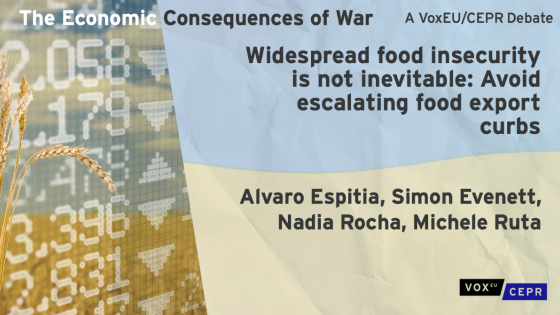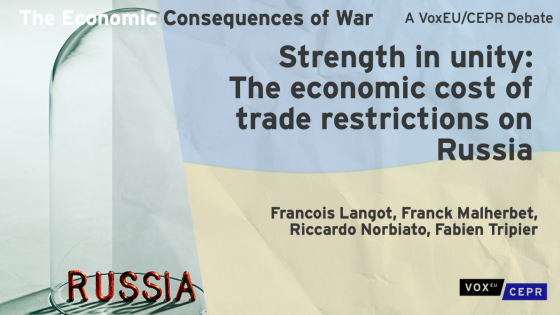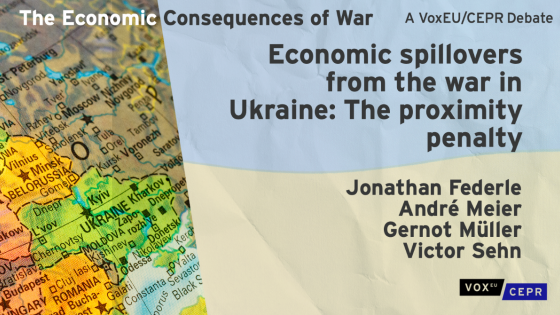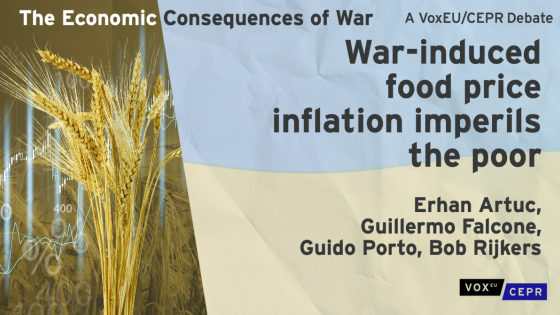Editors' note: This column is part of the Vox debate on the economic consequences of war.
Ukraine is the world’s first, fourth, and fifth largest exporter of sunflower seeds, maize, and wheat, respectively. Combined with Russia, exports of products like wheat are roughly one quarter of world exports. The war has disrupted supplies in world markets, with large consequences for prices of food products (Glauber and Laborde 2022). Increased exports from other food producing countries can only in part compensate for this loss (Chepeliev et al. 2022). In this context, short-sighted government interventions can make a bad situation worse, adding to the severe economic fallout from Russia’s invasion of Ukraine (Artuc et al. 2022, Federle et al. 2022, Langot et al. 2022).
This column, based on trade policy monitoring1 by the World Bank and the Global Trade Alert and on our recent work (Ruta et al. 2022), documents the surge in trade policy activism, especially export restrictions, in food markets since the beginning of the war in Ukraine. It also provides a first assessment of how these measures are impacting food prices focusing on the case of wheat. Food insecurity globally can be at risk if governments indulge in a prisoner’s dilemma over agricultural trade. A commitment by large food exporters to avoid escalating protectionism can help calm markets and avoid extreme outcomes.
Rising trade policy interventions in food markets
Rising global food prices have typically induced differential policy responses, as governments try to shield domestic markets from price surges. Some food-importing countries lower import restrictions or subsidise consumption, and some food-producing countries curb exports.
In the early stages of the COVID-19 pandemic, many countries actively used trade policy to respond to domestic needs in the presence of potential shortages in food supplies. Despite the rapid surge in export and import measures in early 2020, mostly driven by fears of scarcity rather than actual conditions in food markets, the situation stabilised and trade measures levelled off. Policy activism resurfaced in the later part of 2021 and early 2022, driven by the upward pressures on food prices with a slow cumulation of measures.
The war in Ukraine has radically changed the situation (Figure 1). A total of 67 new trade policies (87 including subsidies) were imposed or announced between the beginning of the conflict on 23 February and 7 April 2022 (129 since the beginning of the year). This surge has been dominated by new export bans and export-licensing requirements (38 measures), followed by import bans and import quotas (13 measures) and liberalising import reforms such as tariff cuts (13 measures).
Figure 1 Number of active trade policies on food and fertilizers in force between 1 January and 7 April 2022
Source: Authors using World Bank and Global Trade Alert trade policy monitoring in essential goods.
Twenty nations are responsible for the increase in export controls since the beginning of the war, especially in Europe and Central Asia (Figure 2). Examples of measures implemented during this period include export bans on wheat, corn, and other grains imposed by Russia to countries outside the Eurasian Economic Union, bans of vegetable oils, maize, and wheat imposed by Serbia, and export licensing requirements for grains imposed by Hungary. Export controls were also imposed by food-importing nations such as Algeria, which introduced a ban on consumer products such as sugar, pasta, oil, and semolina, and Egypt, which imposed a ban exports of cooking oil, corn, and wheat.
Figure 2 Regional breakdown of new trade policies on food and fertilizers imposed between 23 February and 7 April 7
Source: World Bank and Global Trade Alert trade policy monitoring in essential goods.
Policymakers have taken measures to alleviate pressures in national food markets. Since the beginning of the war, 38 governments from every continent except North America have implemented support measures in favour of the agricultural sector, such as subsidies to farmers for fertiliser, and have subsidised food purchases by consumers. Azerbaijan, for instance, announced the allocation of up to US$44.1 million in subsidies to cover the difference in domestic and international prices of wheat and flour products.
Reductions of existing restrictions to food imports are also aimed at reducing pressures on domestic prices. Thirteen measures have been taken since the beginning of the war to reduce or remove import barriers on food and fertilisers. For instance, on 3 March, Colombia decreased to zero import duties on corn, seeds, and resinoid oils, among other food products. On 25 March, the government of the Philippines decreased the tariff on corn in-quota imports from 35% to 5%.
Escalating trade measures drive up food prices
Increasing export restrictions on staples such as wheat and corn and on fertilisers are magnifying the surge in food prices caused by the war in Ukraine (Figure 3). The reason is that these policy interventions create a multiplier effect. Export restrictions mitigate pressures on domestic food markets by diverting supplies from the world market. The surge in world prices that results from these measures leads other governments to retaliate by imposing new export restrictions, leading to a further surge in prices. As research shows (Giordani et al. 2016), trade interventions contributed to an increase in world food prices of 13% during the 2008-11 global food crisis, and of 30% for wheat.
Figure 3 International wheat prices and trade policy measures
Source: Capital IQ commodity price statistics and on World Bank and Global Trade Alert trade policy monitoring of essential goods.
A multiplier effect seems to be already in place, as shown in the sequence of policy responses in Europe and Central Asia. These trade measures are contributing to driving up world food prices. Bans on wheat exports imposed by Russia and smaller exporters like Serbia, North Macedonia, and others imposed between the beginning of the war and 7 April cover 16% of world trade and are responsible for a 7 percentage point increase in world wheat prices (i.e. roughly one-sixth of the observed price surge). The imposition of a quota on wheat exports announced by Kazakhstan, a large producer of this crop, would cut down its exports by 80% relative to 2019. The impact would be to drive the world price of wheat up by close to one additional percentage point.
This price effect is economically sizeable per se and can induce further policy activism and disruption ahead. If any of the top five exporters of wheat were to ban exports, the cumulative effect of these measures would be to increase the world price by at least 13%, and much more if others react. Price-insulating trade policies on the import side and consumption subsidies would further magnify world price effects. Moreover, the effects of export restrictions in one market spill over to other markets, propagating price surges. The recent ban on exports of palm oil by Indonesia, the world’s largest exporter of this product, follows export restrictions on sunflower oil – a palm oil substitute used for cooking – imposed by Russia, the second largest exporter of sunflower oil after Ukraine.
Widespread food insecurity is not inevitable: Confidence-building measures are needed
While the consequences of the war on food markets will be difficult to manage, a more catastrophic scenario can be avoided. Large exporters of food products like the US, Canada, the EU, Australia, Argentina, Brazil – which together represent more than 50% of global exports of key staples like wheat, barley, and corn – could make a clear joint statement that they will not restrict their exports of staples (Malpass 2022). Securing these flows would allow markets for these critical commodities to continue working, helping to preserve the stability of global food markets – and well beyond these markets.
References
Artuc, E, G Falcone, G Porto and B Rijkers (2022), “War-induced food price inflation imperils the poor”, VoxEU.org, 1 April.
Chepeliev, M, M Maliszewska and M S E Pereira (2022), “Effects on trade and income of developing countries”, Chapter 1 in M Ruta (ed.), The Impact of the War in Ukraine on Global Trade and Investment, World Bank.
Federle, J, A Meier, G Müller and V Sehn (2022), “Economic spillovers from the war in Ukraine: The proximity penalty”, VoxEU.org, 18 April.
Giordani, P E, N Rocha and M Ruta (2016), “Food prices and the multiplier effect of trade policy”, Journal of International Economics 101: 102-122,
Glauber, J and D Laborde (2022), “How will Russia’s invasion of Ukraine affect global food security?”, IFPRI Blog, 24 February.
Langot, F, F Malherbet, R Norbiato and F Tripier (2022), “Strength in unity: The economic cost of trade restrictions on Russia”, VoxEU.org, 22 April 22.
Malpass, D (2022), “A New Global Food Crisis Is Building”, Barron’s, 9 April.
Ruta, M, N Rocha and A Espitia (2022), “Effects on food trade”, Chapter 2 in M Ruta (ed.), The Impact of the War in Ukraine on Global Trade and Investment, World Bank.
Endnotes
1 www.worldbank.org/en/topic/trade/brief/coronavirus-covid-19-trade-policy-database-food-and-medical-products










